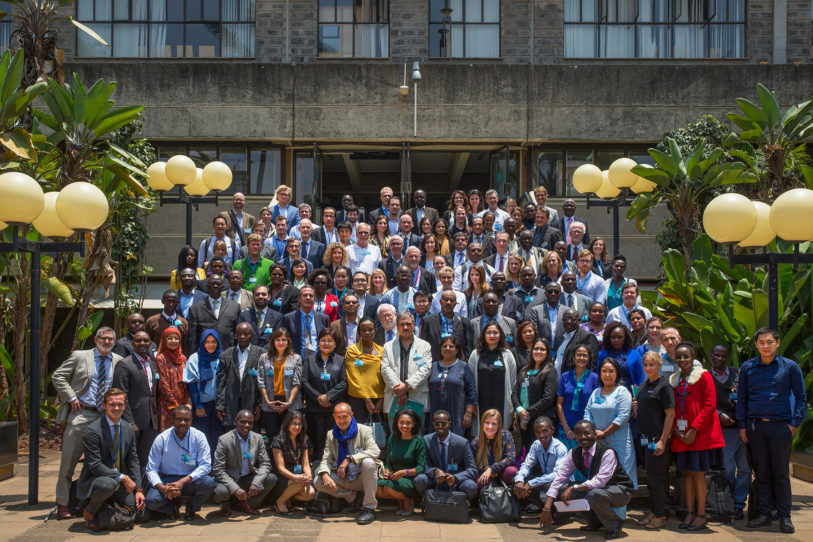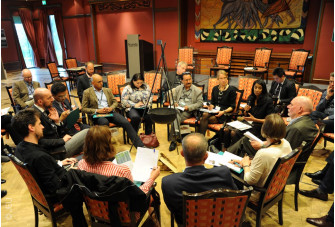Themes and topics of the forum & summary of key outcomes
THEME 1. Readiness for Environmental Emergency Response
This session comprised three roving sessions: a) learning from past responses: experiences from around the world; b) getting ready to respond: exercises and trainings; and c) local level prevention and preparedness for technological hazards and environmental emergencies. Participants had an opportunity to attend two of the three sessions.
A.) Learning from past responses: experiences from around the world
While progress has been made to incorporate environmental considerations into emergency response at both the system and country levels, serious challenges persist. Through interactive discussions, participants shared their experiences of environmental emergency response missions and identified lessons learned.
B.) Getting ready to respond: exercises and trainings
“Before anything else, preparation is the key to success.” Preparing for disasters is crucial not only for communities at risk, but also for those organizations and staff involved in emergency response. Disaster responders do not always have access to environmental expertise, nor are they always aware of the linkages between environment and emergencies. Participants recognized that training and simulation exercises are key to ensuring responders are ready to work together, move quickly, and efficiently start response planning and aid delivery.
C.) Local level prevention and preparedness for technological hazards and environmental emergencies “Community involvement in data collection is key for awareness raising”. As a part of the key outcomes of the section on empowering local authorities and communities to ensure coordinated prevention and preparedness, a step-by-step process was recommended. This included getting the right participants on board, linking to existing disaster risk reduction (DRR) programmes, improving awareness in the community, developing plans for local community preparedness, and building local capacity to implement emergency plans. Such a recommendation aims to promote participation revolution, in which potentially affected populations at the grassroots level are included in local data collection and the knowledge creation process. This in turn recognizes the use of the Flash Environmental Assessment Tool (FEAT) 2.0, which must be increased to enable local actors and communities to conduct rapid risk assessments.
THEME 2. Integrating Environment in Humanitarian Response
This session comprised three roving sessions, which engaged participants in discussions on a range of issues including: a) energy provision in humanitarian settings; b) environmental management systems and c) the need for improved coordination between environment and humanitarian actors, both pre- and post- disaster.
A.) Country experiences of reducing environmental damage through improved provision of energy in humanitarian settings
Humanitarian emergencies have detrimental environmental impacts, in part due to the manner in which energy is provided in these situations. Reliance on solid fuels, such as firewood, is not only harmful to the health of refugees and displaced communities, but it also has the potential to exacerbate tensions with host populations, and increase rates of deforestation. Many humanitarian operations are also dependent on diesel generators, which can have negative environmental consequences. Nevertheless, new opportunities to reduce environmental impacts and operating costs are emerging due to recent innovations in the provision of energy in humanitarian settings, and increased engagement with non-conventional humanitarian partners. Participants discussed the issue of energy provision in humanitarian settings over three breakout sessions. Two of these focused on experiences from sub-Saharan Africa, and one highlighted experiences from the Middle East with regional environmental experts
B.) How to apply environmental management systems
Public and international institutions, including the United Nations agencies, are increasingly committing themselves to achieving a range of environmental objectives. One way to achieve these objectives is to implement environmental management systems (EMS) in line with ISO 14001, the globally recognized standard for improving environmental performance.
This session introduced participants to EMS and ISO 14001, and examined how challenges to implement these systems within international and governmental institutions can be overcome. Participants recognized that EMS allows for a systematic approach to identify environmental problems and focus on subsequent actions, as well as helps practitioners to better consider environmental impacts and apply environmental safeguards.
C.) Coordinating environmental assessments in humanitarian response
This session comprised three identical rotating sessions and allowed participants to contribute to the “Framework for Environment in Humanitarian Action”, as well as consider critical aspects of coordinating environmental assessments. The Framework maps out key entry points for the environment and environmental assessments in the humanitarian system at four levels: (i) preparedness, (ii) disaster-wide level, (iii) national level coordination and (iv) direct programming implementation. The dynamic conversations held for each of the four levels enabled the “Framework for Environment in Humanitarian Action” to take an important leap forward with inputs from over 150 participants.
Theme 3. Environment in Conflict Settings
The final theme “Environment in Conflict Setting” targeted the importance of collecting environmental data and monitoring risks before, during and after conflicts. This session addressed various challenges and identified best practices from existing and emerging field- and remote-based data collection methods used by a wide range of organizations working in this area. With respect to remote-based data collection, participants identified vital data to include geographic conditions, population data, potential sources and vectors of pollution and impact zones, amongst others. Verifiable information, authenticated by multiple sources, was considered to be a major challenge. During discussions, it was noted that data collectors and users should be conscious of the risk of politicized data being used to serve the purposes of parties to a conflict.
 and Emergencies Forum (EEF) is a unique global event organized by the UN Environment/OCHA Joint Unit (JEU). The Forum brings together stakeholders from around the world to showcase innovations in environmental emergency preparedness and response, and to highlight current efforts on integrating environmental risk in humanitarian action.
and Emergencies Forum (EEF) is a unique global event organized by the UN Environment/OCHA Joint Unit (JEU). The Forum brings together stakeholders from around the world to showcase innovations in environmental emergency preparedness and response, and to highlight current efforts on integrating environmental risk in humanitarian action. Star Awards
Star Awards

